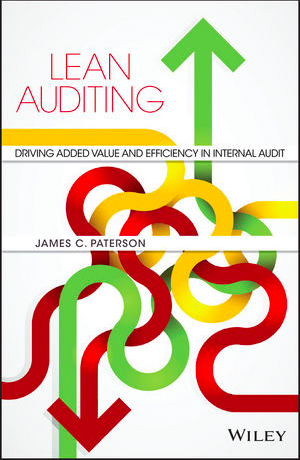
We are honored to publish a multi-part article by James C. Paterson, Director of Risk & Assurance Insights, Ltd. He recently published a book on Lean Auditing and has put together this great overview of how auditors can use lean principles to transform the way they work.
This is part one of a three-part series on the topic. This post provides a brief introduction to lean auditing. Add your thoughts in the comment section and be automatically entered to win one of four free copies of James C. Paterson’s book.
By James Paterson
When I was Chief Audit Executive (CAE) for Pharmaceuticals company AstraZeneca PLC, I became interested in two key questions about internal auditing:
- How could I ensure my internal audit function was adding the maximum value it could?
- How could I be sure the internal audit function was as efficient as it could be – moving beyond benchmarking and going back to first principles?
One of my audit team alerted me to lean ways of working and suggested these would help us with the challenges of both improving value-add and productivity. Our efforts delivered a 20% increase in our productivity and also achieved recognition in the Audit Director Roundtable for our improved ways of reporting our audit results in an engaging way (which flowed directly from our lean ways of working).
Several years later I started to work as a freelance consultant in risk, audit and assurance and I took what I had learned about lean auditing and applied and enhanced it with my clients. After writing an article on Lean Auditing for the IIA North America in 2013, I was approached by John Wiley & Sons to write a book on Lean Auditing. In addition to interviews with over 20 heads of audit, I was lucky enough to interview Richard Chambers the CEO of the IIA in the US, Norman Marks, and also Chris Baker the technical manager of the IIA UK. The book was published in 2015, which then led to an invitation to present the key messages at the IIA International Conference in New York in 2016. I was delighted to have over 340 attend my presentation at the conference and the lean auditing book was the most popular at the Wiley stand during the conference.
Following the interest at the conference we thought it might be useful to offer a brief overview of lean, lean auditing and some of the key messages from the book to those who may have missed what I had to say.
What is lean and what can it offer us?
The label “lean” was first used in 1987 by John Krafcik, a student at MIT who examined the Toyota Production System and observed: “It needs less of everything to create a given amount of value, so let’s call it lean.”
Lean techniques have now been successfully applied in a range of sectors outside of motor manufacturing (e.g. in white goods and pharmaceuticals manufacturing) and, increasingly, in service sectors (e.g. airlines, healthcare, etc.). Typical benefits obtained from lean ways of working include:
- Reductions in: Defects, Lead times, cost, inventory and waste;
- Improvements in: Customer satisfaction, Productivity, Capacity, Responsiveness and Quality.
Lean ways of working have also been used in relation to finance, HR and IT. And the application of lean to internal auditing can be thought of as just a continuation of this evolution. However, the key to success is to understand how to intelligently apply lean principles and techniques whilst respecting key IIA standards. The result is a “progressive” approach to internal auditing that may match the views of many readers, with the benefit of having a solid underpinning in theory and practice in relation to how to balance efficiency with quality and value.
Key principles of lean
The five key principles of lean can be summarized as:
- Understand value from the point of view of the customer;
- Identify the value stream;
- Create activities that Flow;
- Pull through to deliver “just in time”;
- Aim for perfect process without waste/rework or bottlenecks.
It is important to recognize therefore that lean is not simply about reducing costs although managing and reducing costs is a by-product of lean ways of working. This also means that working in a lean way is often a much more positive than most people realize and this is a regular feedback theme I receive from those who attend lean auditing workshops.
. . . .
Next up, Mr. Paterson will provide some practical examples of using lean in day-to-day audit work.
Don’t forget to leave a comment to be entered into our Lean Auditing book giveaway. The contest will close and the winners announced the third week in November.

